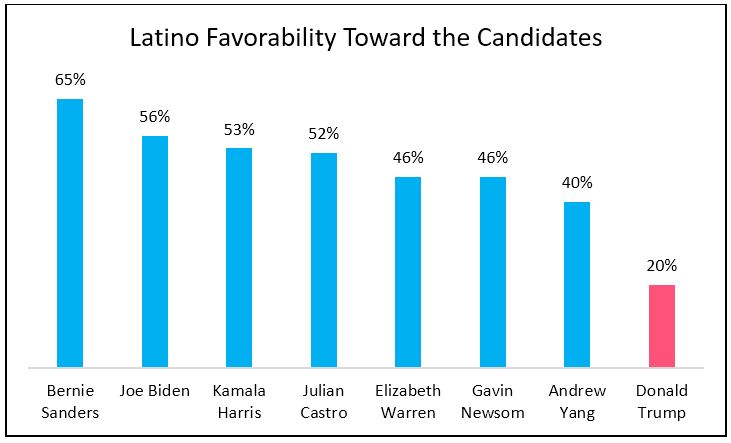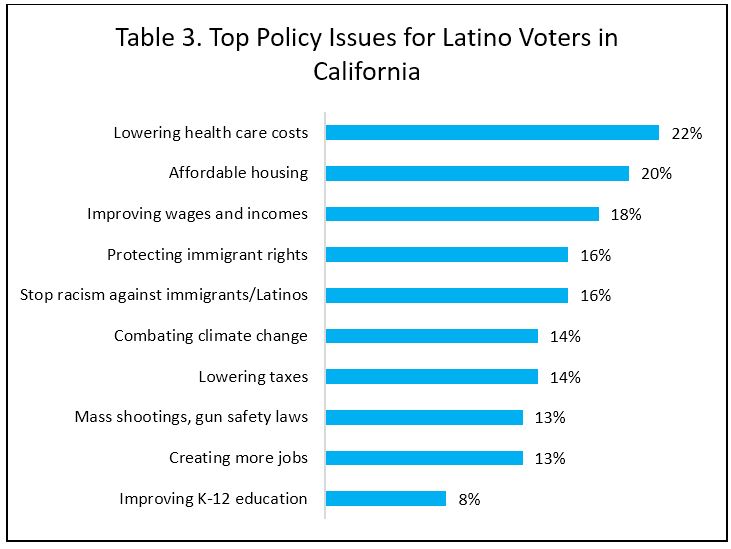The path to winning the Democratic Party primary runs through California and its sizable Latino electorate. With 495 delegates at stake, the Golden State will be one of the most coveted prizes in this primary election. Among the Democratic Party hopefuls, one candidate, Bernie Sanders, has invested serious time and effort in winning the state and Latino voters. With campaign offices in Latino enclaves like East Los Angeles and a sizable Latino campaign staff, Bernie Sanders is making it clear that he’s serious about winning the Latino vote. Those efforts are paying off according to a recent survey of Latinos in California by The Latino Community Foundation and Latino Decisions. In the survey, Latino voters were asked to state the degree to which they felt favorable or unfavorable toward various candidates, including President Trump. Table 1 shows the percentage of respondents who were “very” to “somewhat” favorable toward the candidates.
Bernie Sanders is a clear favorite, with two-thirds of Latinos rating the Vermont Senator favorably. A difference of 9-points separates him and Joe Biden. Although the differences between Joe Biden, Kamala Harris and Julian Castro are within the margin of error, the gap separating Bernie from the pack is significant. In some cases, Bernie Sanders has a 20-point advantage over his rivals, including Elizabeth Warren. The results further show that regardless of Democratic candidates, all are rated far more favorably than Donald Trump. Latinos between the ages of 18-29 years and Spanish-speakers are Bernie’s biggest supporters. The former give Bernie a 70 percent favorability rating, while the latter favor him by 72 percent. Other questions in the survey similarly reveal a strong preference for the Vermont Senator. When Latinos were asked who they are currently planning to vote for, Bernie came first, followed by Joe Biden and Elizabeth Warren. Once again, a 9-point difference separates Bernie Sanders and Joe Biden, while a 20-point difference separates Bernie Sanders and Elizabeth Warren.
Ultimately, the general election is going to pit the top Democrat against Donald Trump. In the survey, respondents were presented with different scenarios pairing several Democratic hopefuls against Trump. The results show that regardless of the scenario, Latinos overwhelming prefer the Democratic candidate. However, among the Democratic contenders, Bernie Sanders garnered the most votes from Latinos. In this hypothetical race, 83 percent of Latinos said they would vote for Bernie, while a mere 16 percent supported Trump (see Table 2). This distribution of the Latino vote is similar to that received by Hillary Clinton nationally in 2016. However, a major difference between then and now is that the Latino electorate will have grown by several million voters. Bernie’s support extends across different segments of the Latino electorate. Yet, Latino millennials (persons 18 to 29 years old), who are the fastest growing segment of the electorate, are among his strongest supporters. Support slips among Latinos earning $80K or more annually, yet they too favor Bernie over Trump by a ratio of three to one.
More important than the placement of Bernie Sanders’s offices or the size and diversity of his staff are the policy positions that are central to his campaign. Contrary to popular belief, Latinos are not single-issue voters and have been shown to support candidates whose policy positions align with their own. Heading into the 2020 election, what are the policy priorities of Latinos?
Lowering health care costs emerges as the top policy issue for Latinos according to the survey. This is followed by affordable housing and improving wages and incomes. Interestingly, protecting immigrant rights and stopping racism against immigrants and Latinos rank 4th. The remaining top ten issues include environmental protection, gun safety, jobs and improvements to education. One of the hallmarks of Bernie’s campaign has been a “Medicare For All” single-payer, national healthcare plan. Our own studies show that health care costs are a significant burden for many low-income Latino families. It comes as no surprise that this is emerging as one of the top issues facing Latinos. His other policy priorities, including Housing for All, the 21st Century Economic Bill of Rights, and the Green New Deal parallel Latino policy preferences. Bernie’s consistency, progressivism and history of grassroots activism may be an additional draw for working class and young Latinos who are facing greater economic uncertainty.
It is almost obligatory for Democratic and Republican presidential candidates to say they want to win the Latino vote. Even Trump claimed recently that “nobody loves Hispanics more.” Inevitably, disappointment sets in as most presidential hopefuls put minimal effort toward mobilizing and winning over Latinos. Bernie Sanders is deviating from this unfortunate tradition. The opening of five campaign offices in California, including one in the heart of East Los Angeles, sent a powerful message that the senator was serious about California and its Latino voters. The addition of a significant number of Latino staffers, including DACA recipients, was further evidence that his campaign is going beyond symbolic politics. Bernie’s policy positions on affordable health care, affordable housing, improving wages, protecting immigrant rights and the environment are aligned with those of Latino voters. In short, Bernie Sanders is winning the hearts and minds of Latino voters in California through substance, not symbolism. Latinos are “feeling the Bern” but have yet to become Bernie’s firewall. Other candidates could win Latino voters if they follow Bernie’s example of putting substance behind their messages. The fact that 74 percent of Latinos surveyed said they are “100% certain to vote” in the primary election means that they, along with other Californians, could make or break a campaign. The days of pandering to Latino voters by eating tamales, speaking broken Spanish, and wearing cheesy sombreros belong in the dustbin of history. For the moment, Senator Bernie Sanders is one of the few who recognizes that reality.
Methodology
Latino Decisions surveyed 807 Latino registered voters between October 30-Nov 7, 2019. Interviews were collected via landline, cell phone, and web. The online portion was conducted in a respondent self-administered format, and the survey and invitation was available to respondents in English or Spanish. The full data are weighted to match the Latino voter population in the most recent Census ACS data file for age, gender, education, nativity, ancestry, and voter registration status. A post-stratification raking algorithm was used to balance each category to the Census estimates. The survey carries a margin of error of +/- 3.45 percentage points.
Adrian D. Pantoja is a Professor of Politics at Pitzer College and Senior Analyst for Latino Decisions





